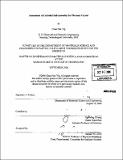Assessment of colloidal self-assembly for photonic crystal
Author(s)
Yip, Chan Hoe
DownloadFull printable version (6.930Mb)
Other Contributors
Massachusetts Institute of Technology. Dept. of Materials Science and Engineering.
Advisor
Yet-Ming Chiang.
Terms of use
Metadata
Show full item recordAbstract
A suspension of monodisperse colloids has an interesting property of self-assembling into a three-dimensional ordered structure. This crystalline material has attracted significant interest on the implementation of photonic crystals, which have practical applications in reflectors, filters, resonators, and waveguides. In this thesis, self-assembly of colloidal crystals and photonic crystal technologies are reviewed. Potential colloidal photonic and non-photonic devices were presented and their values/limitations were discussed. Colloidal photonic crystals were assessed on their technical capabilities, growth techniques and fabrication cost. In this assessment, the bulk colloidal photonic crystals are found to be inherently robust against stacking disorder, cracks and voids. The high reflectance performance and lattice parameter tailoring are useful for implementing reflectors, optical switch and sensors. Besides, the anomalous dispersion characteristic near to the band edges or near to flat bands of the photonic band diagram is suited for superprism and light harvesting applications. Potentially, the unique characteristics of colloidal photonic crystal could be capitalized in a low cost micro-fabrication model. Finally, the study has shown that it is more technically and commercially viable to implement bulk colloidal photonic crystal applications rather than lithographically-defined types.
Description
Thesis (M. Eng.)--Massachusetts Institute of Technology, Dept. of Materials Science and Engineering, 2006. Includes bibliographical references (p. 87-93).
Date issued
2006Department
Massachusetts Institute of Technology. Department of Materials Science and EngineeringPublisher
Massachusetts Institute of Technology
Keywords
Materials Science and Engineering.